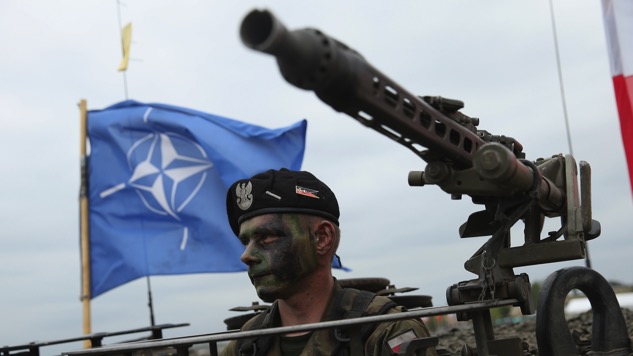Ukrainian President Volodymyr Zelenskyy declared on March 8 that he would no longer push for his country’s participation in the North Atlantic Treaty Organization (NATO). Ukraine’s desire to join the organisation has been at the heart of its geopolitical disagreements with Russia.

Ukraine’s discussion and collaboration with NATO dates back to 1991, when the newly formed nation became a member of the North Atlantic Cooperation Council, and then the Partnership for Peace Program in 1994. As part of its strategic foreign and security strategy, the Ukrainian Parliament passed legislation in 2017 to reinstate Ukraine’s participation in the organisation. In 2019, the country’s Constitution was amended to reflect this change.
President Mr. Zelenskyy authorised the National Security Strategy in 2020, which called for the formation of a unique cooperation with the organisation and, as a result, the membership’s security.
At the Bucharest Summit in 2008, it was decided that Georgia and Ukraine will join the alliance in the future. As a result, the current statement casts doubt on the entire process.
The North Atlantic Treaty, sometimes known as the Washington Treaty, stipulates that the treaty’s parties aspire to foster stability and prosperity in the North Atlantic region. The treaty declares that the signatories confirm their belief in the United Nations Charter’s aims and ideals, as well as their wish to live in peace with all people and countries.
The treaty’s wording says, “They are decided to unify their efforts for collective defence and the maintenance of peace and security.”
Article 10 of the treaty allows a new member to join the treaty with the unanimous consent of the current members.
Once the member nations have reached an agreement on a country’s future membership, the country is invited to begin accession discussions with the alliance.
MAP: They may be invited to join the Membership Action Plan after that (MAP). The fact that you’ve made it this far does not guarantee you’ll be accepted. It is a preparatory framework that provides guidance, help, and practical support to candidate nations based on their individual needs. The process would come to a close with the establishment of a clear timeframe for completing the required reforms. It is possible that it will continue even after the candidate nations have been admitted.
Annually, the alliance produces a report that informs aspiring countries on their success in their yearly national programmes and identifies areas for future effort. According to NATO’s website, “the list of topics highlighted for debate does not constitute membership requirements and is meant to contain those concerns that the seeking nations themselves have recognised as matters that they desire to address.”
Confirmation of intent: At NATO’s headquarters in Brussels, specialists and officials from the invited nations begin the procedure. The goal is to gain formal confirmation of the invitee’s desire and capacity to fulfil the NATO membership’s political, legal, and military duties and commitments. They must also take steps to safeguard the organization’s confidential material and prepare their security and intelligence services to collaborate with the NATO Office of Security.
Letter of intent: The applicant country must send NATO an official letter of intent in the second phase of the procedure. This serves as confirmation of the organization’s duties and promises.
The modifications: It then proceeds on to the requisite revisions to make the invitees parties to the Washington Treaty, followed by approval of the constitutional protocols of the applicant nations to expedite membership.
Adherence to the Treaty: The Secretary General would then invite any possible new members to join the North Atlantic Treaty. This occurs when all NATO members notify the United States government, which serves as the repository of the Washington Treaty, of their acceptance of the application.
Following the submission of the applicant’s papers of admission with the US State Department, the applicant becomes a member of NATO.
The duties under the MAP
The five chapters of MAP identify concerns that may be addressed, as well as mechanisms for moving forward with preparations for “potential future membership.” They include topics such as politics and economy, defence and military, natural resources, security, and law.
Political and economic issues: Aspirants would have to demonstrate their ability to resolve international disputes through peaceful means, their commitment to the rule of law and human rights, their refusal to use threat or force, their ability to contribute to the development of peaceful and friendly international relations, their ability to unite efforts for collective defence, and their ability to establish democratic and civilian control of armed forces, among other things.
Defence: In addition to militarily contributing to collective defence and the alliance’s new missions, aspirant countries are expected to improve their military capabilities and ensure full participation in NATO’s Partnership for Peace Program (PfP). They would also be expected to engage in the alliance’s collective defence planning, NATO agencies, and, depending on the circumstances, maintain standardisation and/or interoperability.
Resources: Applicants are expected to contribute appropriate budget resources to satisfy the membership’s responsibilities as well as NATO’s common-funded operations at agreed-upon cost shares.
Security: In accordance with NATO security policy, invitees would be required to put in place necessary measures and processes to ensure the security of sensitive information.
Legal Issues: Aspiring nations would have to examine their local laws to guarantee that they are in compliance with NATO norms and regulations. Domestic law should be as compliant as feasible with NATO-wide cooperation procedures and conditions.











